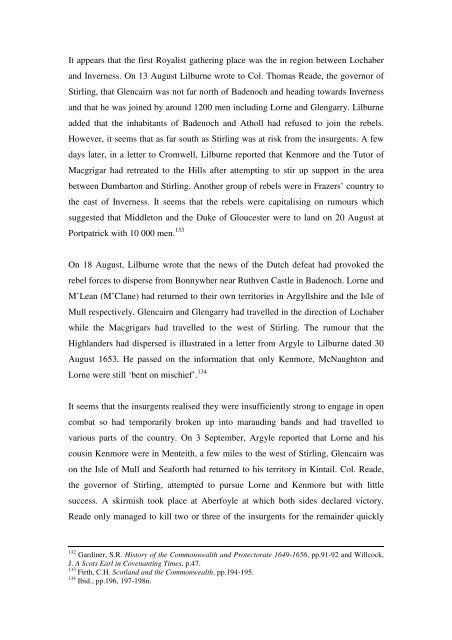The Glencairn Uprising, 1653-54 Helen Baker Department of ...
The Glencairn Uprising, 1653-54 Helen Baker Department of ...
The Glencairn Uprising, 1653-54 Helen Baker Department of ...
Create successful ePaper yourself
Turn your PDF publications into a flip-book with our unique Google optimized e-Paper software.
It appears that the first Royalist gathering place was the in region between Lochaber<br />
and Inverness. On 13 August Lilburne wrote to Col. Thomas Reade, the governor <strong>of</strong><br />
Stirling, that <strong>Glencairn</strong> was not far north <strong>of</strong> Badenoch and heading towards Inverness<br />
and that he was joined by around 1200 men including Lorne and Glengarry. Lilburne<br />
added that the inhabitants <strong>of</strong> Badenoch and Atholl had refused to join the rebels.<br />
However, it seems that as far south as Stirling was at risk from the insurgents. A few<br />
days later, in a letter to Cromwell, Lilburne reported that Kenmore and the Tutor <strong>of</strong><br />
Macgrigar had retreated to the Hills after attempting to stir up support in the area<br />
between Dumbarton and Stirling. Another group <strong>of</strong> rebels were in Frazers’ country to<br />
the east <strong>of</strong> Inverness. It seems that the rebels were capitalising on rumours which<br />
suggested that Middleton and the Duke <strong>of</strong> Gloucester were to land on 20 August at<br />
Portpatrick with 10 000 men. 133<br />
On 18 August, Lilburne wrote that the news <strong>of</strong> the Dutch defeat had provoked the<br />
rebel forces to disperse from Bonnywher near Ruthven Castle in Badenoch. Lorne and<br />
M’Lean (M’Clane) had returned to their own territories in Argyllshire and the Isle <strong>of</strong><br />
Mull respectively. <strong>Glencairn</strong> and Glengarry had travelled in the direction <strong>of</strong> Lochaber<br />
while the Macgrigars had travelled to the west <strong>of</strong> Stirling. <strong>The</strong> rumour that the<br />
Highlanders had dispersed is illustrated in a letter from Argyle to Lilburne dated 30<br />
August <strong>1653</strong>. He passed on the information that only Kenmore, McNaughton and<br />
Lorne were still ‘bent on mischief’. 134<br />
It seems that the insurgents realised they were insufficiently strong to engage in open<br />
combat so had temporarily broken up into marauding bands and had travelled to<br />
various parts <strong>of</strong> the country. On 3 September, Argyle reported that Lorne and his<br />
cousin Kenmore were in Menteith, a few miles to the west <strong>of</strong> Stirling, <strong>Glencairn</strong> was<br />
on the Isle <strong>of</strong> Mull and Seaforth had returned to his territory in Kintail. Col. Reade,<br />
the governor <strong>of</strong> Stirling, attempted to pursue Lorne and Kenmore but with little<br />
success. A skirmish took place at Aberfoyle at which both sides declared victory.<br />
Reade only managed to kill two or three <strong>of</strong> the insurgents for the remainder quickly<br />
132 Gardiner, S.R. History <strong>of</strong> the Commonwealth and Protectorate 1649-1656, pp.91-92 and Willcock,<br />
J. A Scots Earl in Covenanting Times, p.47.<br />
133 Firth, C.H. Scotland and the Commonwealth, pp.194-195.<br />
134 Ibid., pp.196, 197-198n.
















